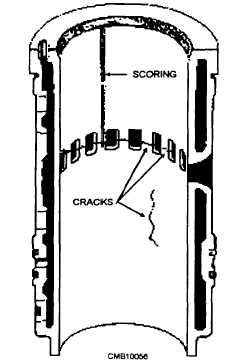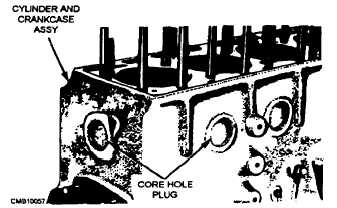In liquid-cooled engines CYLINDER SLEEVES or LINERS (fig. 3-4) are used to provide a wearing surface, other than the cylinder block, for the pistons to ride against. This is important for the following reasons:
Alloys of steel can be used that wears longer than the surfaces of the cylinder block. This increases engine life while keeping production costs down.
Because the cylinders wear more than any other area of the block, the life of the block can be greatly extended by using sleeves. When overhaul time comes, the block can be renewed by just replacing the sleeves.
Using a sleeve allows an engine to be made of other materials, such as aluminum, by providing the wearing qualities necessary for cylinders that aluminum cannot.
There are two types of cylinder sleeves: the DRY-TYPE and the WET-TYPE. A dry-type sleeve does not contact the coolant. The dry-type sleeve is pressed into a full cylinder that completely covers the water jacket. Because the sleeve has the block to support it, it can be very thin. The wet-type sleeve comes in direct contact with the coolant. It is also press-fitted into the cylinder. The difference is that the water jacket is open in the block and is completed by the sleeve. Because it gets no central support from the block, it is made thicker

Figure 3-5. - Cylinder sleeve casualties.
than a dry sleeve. Also because the sleeve completes the water jacket, it must fit so it seals in the coolant. This is accomplished by using a metallic sealing ring at the top and a rubber sealing ring at the bottom. There are three basic ways of securing the sleeves in the cylinder block as follows:
Press in a sleeve that is tight enough to be held by friction.
Provide a flange at the top of the block that locks the sleeve into place when the cylinder head is bolted into place. This is more desirable than a friction fit, because it locks the sleeve tightly.
Cast the sleeve into the cylinder wall. This is a popular means of securing a sleeve in an aluminum block.
Whatever method is used to secure the sleeves, it is very important for the sleeve to fit tightly. This is so the sleeve can transfer heat effectively to the water jackets.
Most cylinder sleeve casualties are directly related to a lack of maintenance or improper operating procedures. Figure 3-5 shows two common types of cylinder sleeve casualties: cracks and scoring. Both types of casualties require replacement of the sleeve.
The cylinder block also provides the foundation for the cooling and lubricating systems. The cylinders of a liquid-cooled engine are surrounded by interconnecting passages cast in the block. Collectively, these passages form the WATER JACKET that allows the circulation of coolant through the cylinder block and the cylinder head to carry off excessive heat created by combustion. The water jacket is accessible through holes machined in the head and block to allow removal of the material used for casting of the cylinder block. These holes are called core holes and are sealed by CORE HOLE PLUGS (freeze plugs). These plugs are of two types: cup and disk. Figure 3-6 shows a typical installation of these plugs.

Figure 3-6. - Core hole plugs installed in cylinder block.
Continue Reading